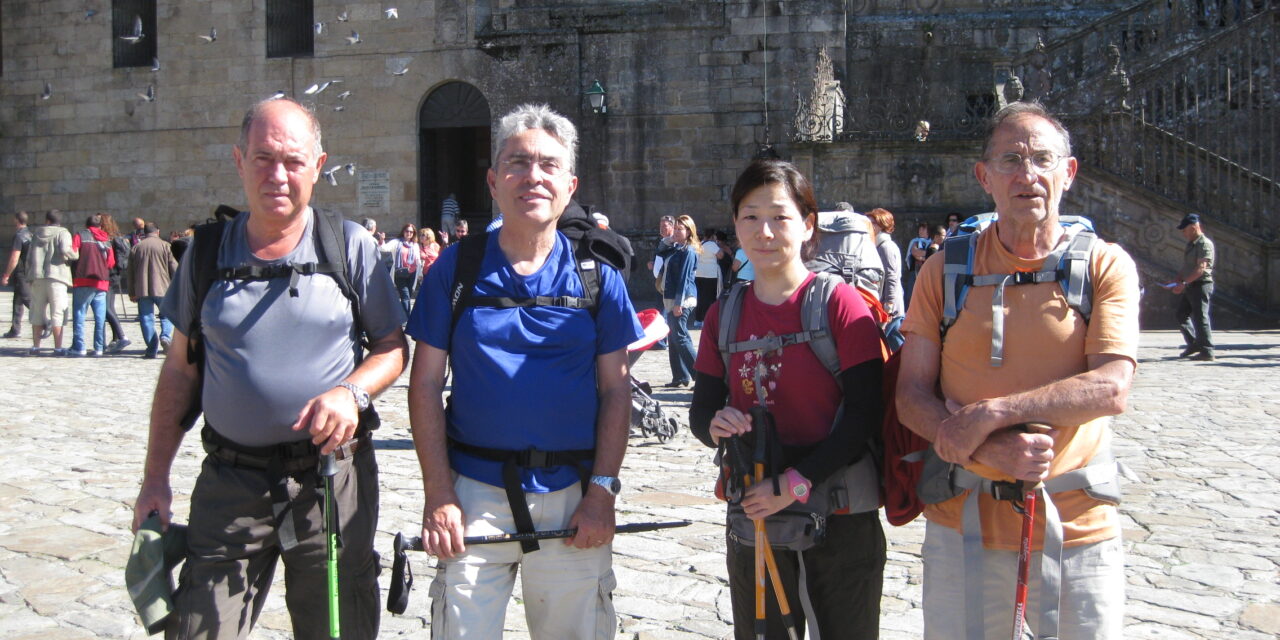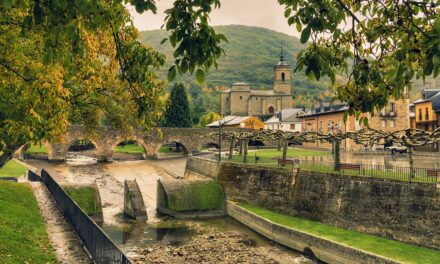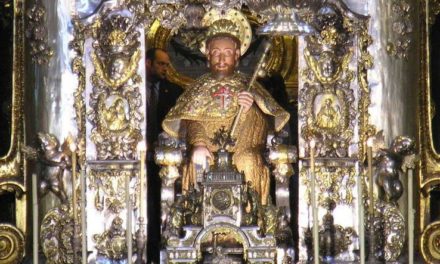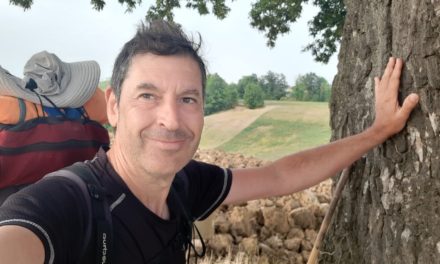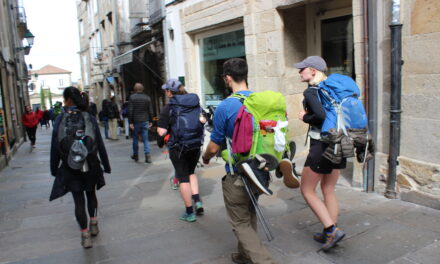Kiyomi Doi is a Japanese cultural anthropologist specialized in pilgrimage. She has a Ph.D. on the Camino de Santiago and has walked 5,000 kilometers as a pilgrim. We met her at the end of her last Camino, in Santiago de Compostela, and we interviewed her about her work and relationship with the Camino.
How did you get to the Camino de Santiago?
That was more than a quarter of a century ago when I was a high school student. One evening, I asked my mother who was watching a TV documentary program, “What is that?”. She answered, “The Camino”. And then I also started watching it together with her. I was surprised by the expansive landscape and the single road passing through it. The camera also captured several people who provided treatment for other pilgrims’ blisters, pilgrims such as a father and a son walking together with little conversation, and a grizzled peregrina who gave up and took a train. I was very impressed there should be such a place on earth and I thought how I wished that I could visit it. But it seemed impossible for me to walk hundreds of kilometres at that time.
What weight did academic studies have in your decision to approach the Camino?
I am not sure whether I can answer your question properly. I have learned everything from the Camino. The research method I have adopted is to expose myself and immerse my whole body in the field. I am a cultural anthropologist, so I have always tried to be faithful to the realities experienced in fieldwork. What I experienced was as if the Meseta were spreading as far as the horizon, people who continue walking onto this ever- widening ground every day and pilgrims helping each other, the rhythmic sound of scallop shells flapping on backpacks. So, therefore, I have researched the Camino with a focus on the relationships between the walking body and the cultural and natural realities rather than the social changes in modern pilgrimages.
What has been your practical relationship with the Camino? Have you done a pilgrimage or had experiences as a hospitalera?
I have walked the Camino many times. I‘ve walked more than 5000km in total. For the first time, from León in 2007, then starting from Saint-Jean-Pied-de-Port in 2008, from San Sebastián, in 2009, etc…When I found the yellow arrow in 2011, I burst into tears; “I finally could return here”. Because the year before, I had been unable to even stand up due to idiopathic cerebrospinal fluid loss. In 2022, after having my child and surviving lymphoma and necrotizing fasciitis, I felt thankful to be back in my second home. I also spent some fruitful time as a hospitalera in Burgo Ranero, Bercianos, and Logroño. I am grateful that the association accepted me, a poor Spanish speaker, and placed me in albergues. I didn’t know that Spanish people were such cleaning enthusiasts. My house is now tidier than before thanks to the volunteer experiences.
Have the meetings with pilgrims or specialists on the Camino played a determining role in your relationship with it? Which people have brought you closer to the Camino?
I still keep in touch with many of my Camino friends, have even visited them, and vice versa. Among them, Richard from the Netherlands, a retired psychotherapist, whom I met in Saint Jean, has been my mentor as well as being a father- figure for more than a decade. Jesús, Kristien, Yago, and Simon and I have had a family commitment for more than a decade. An Italian couple who did ‘hospitaleros’ together have visited my place in Japan. In León, I was really lucky and happy to have a chance to meet Dr. Nancy Frey, whose book “Pilgrims Stories” introduced me to doing fieldwork regarding the Camino. On the Camino, there are great encounters whose relationships continue into my later life.
What have you found on the Camino?
I could answer either from a more spiritual way or a more basic way. But let me say this in another way. The Camino has given me a sense of being grounded, and also has given me a sense of distance and direction. I would rather say “gave me” than “I found”. Hope you understand me. In everyday life, you tend to use a brain which is filled with abstract ideas, you take proximity for granted and move around without any sense of direction. Walking Camino reminds me of the very basic but fundamentally important things which affect your way of thinking.
Japan has an important pilgrimage tradition, do you see similarities and/or differences between the pilgrimage in Japan and the Camino de Santiago?
There are various pilgrimage roads in Japan. Among them, Shikoku Pilgrimage or Shikoku Henro is popular and distinctive. The similarities are the motives and practices of pilgrimage. People visit the sites 88 temples for a variety of purposes such as to meet other people, to practice asceticism or to get over midlife crises, although traditionally it has been a Buddhist pilgrimage dating from the 8th century. Although they are not as numerous as those on the Camino de Santiago, there are walking pilgrims who visit each temple. There has been the custom of “osettai” or alms by the residents which encourages pilgrims, offering food, money, and sometimes temporary lodging, which is a sort of like ‘hospitareros’.
The obvious difference is the shape of the route. While el Camino spreads in one direction, the Shikoku pilgrimage road encircles a single island. I think recently it has become more famous in other countries introduced by TV programs.
Do you think that the Camino de Santiago is well known in Japan? What do you think could bring the Camino closer to your country?
I should imagine many people who are interested in going overseas would know it and admire walking, because travel guide books, you-tube, TV programs, and travelogs have frequently introduced. There is an association of friends of Camino in Japan. In these years, it has not been easy for the Japanese to come to Spain due to the pandemic COVID 19, the war, and a fall in the exchange rate of the yen. In my opinion, el Camino should be visited only by those who are searching for a place like the Camino, rather than be promoted to the general public in Japan. In a few years, hundreds of Japanese pilgrims will walk on the Camino, as in the 2010s.
What is your current job in relation to the Camino?
After obtaining my Ph.D. degree, I now work for a university as a cultural anthropologist and associate professor. My recent interest is how walking on the Camino has changed with the advent of Camino guide apps. In these days, pilgrims have fewer opportunities to get lost, endure pain, and encounter others. I found that personally this is disappointing, in terms of lacking a sense of journey, but anthropologically brings to attention new modes of “rites of passage” by a simple repetition to the final point. Also, “over-tourism” or tourist saturation on the French Way should not be overlooked. Currently, I am studying ways of limiting damage to the social and natural environment.
What wishes or dreams in relation to the Camino de Santiago do you still have to fulfill?
What a nice question you asked me! My dream is someday to walk the Camino (English way maybe) with my family. As a cultural anthropologist, whenever I do my field research, I always have had to leave my husband, who works in Japan, where it is notoriously hard to take long holidays. I want to walk the Camino together with him. Additionally, my daughter, who was born soon after writing up my thesis on the Camino (in Japanese), is named after my Camino experiences. Her name is “Haruka”, which in Japanese means “searching for far-flung places”. I want her never to lose her sense of exploration and not be content with what is easy to understand. One day, I hope to walk and share its profoundness with my daughter on the Camino.

